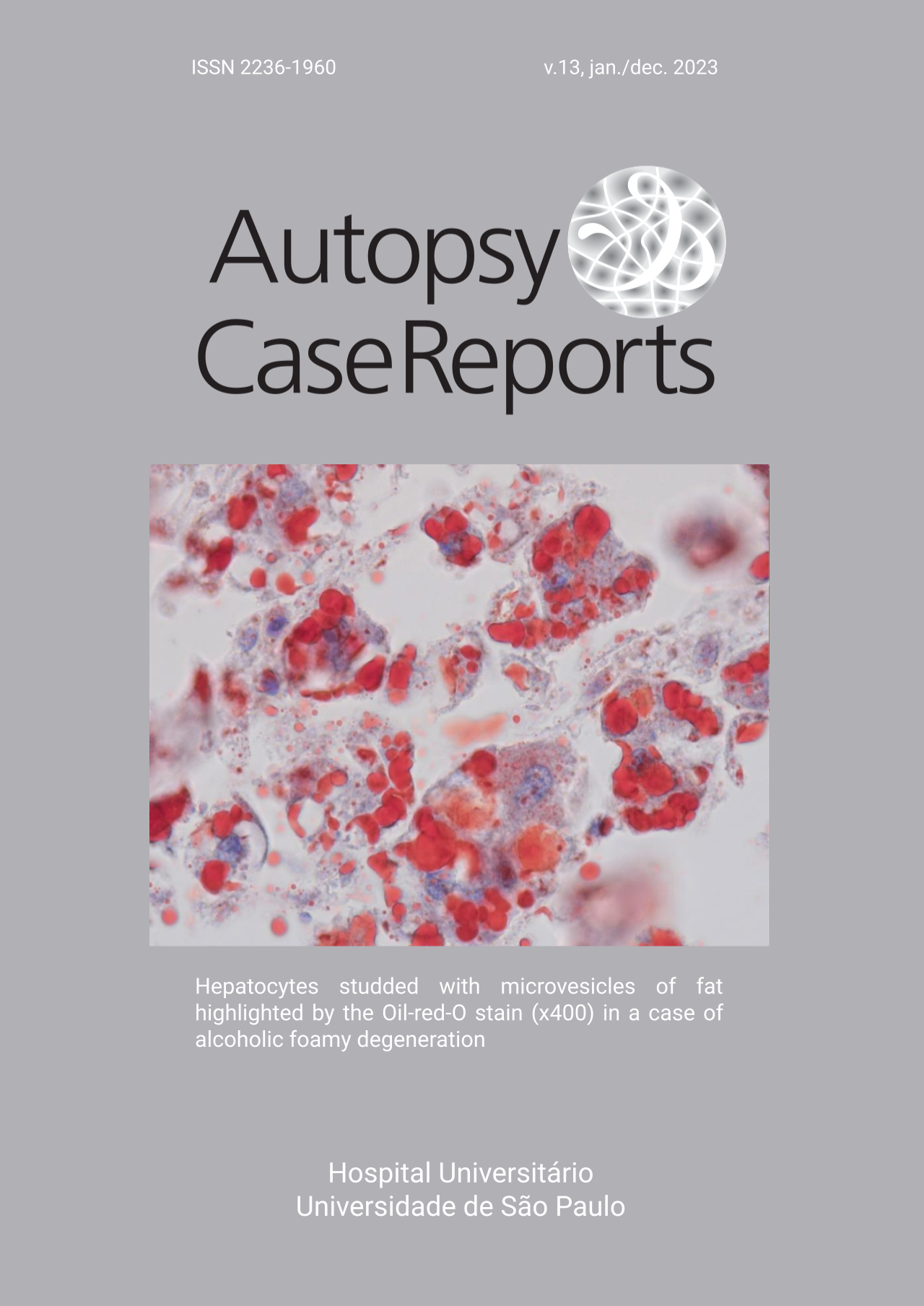Spongiform leukoencephalopathy unveiled in an autopsy of a drug abuser
DOI:
https://doi.org/10.4322/acr.2023.465Keywords:
Forensic Toxicology, Leukoencephalopathy, Progressive Multifocal, Psychoses, Substance-InducedAbstract
Toxic leukoencephalopathy (TLE) is a rare neurological debilitating and fatal condition. It has been previously associated with exposure to leukotoxic offenders such as chemotherapy, cranial radiation, certain drugs, and environmental factors. Currently, it is a commoner white matter syndrome resulting from increased substance abuse, classically by inhaled heroin and other opioids. Herein, we report a case of fatal TLE unveiled in an autopsy of a drug abuser. A 24-year-old male was found dead on the roadside. A day before, he was located in a state of delirium. In this case, the autopsy findings and histopathology characteristics of cerebral cortex involvement particularly directed to speculate the heroine as the principal offender.
Downloads
References
Wolters EC, Stam FC, Lousberg RJ, et al. Leucoencephalopathy after inhaling “heroin” pyrolysate. Lancet. 1982;320(8310):1233-7. http://dx.doi.org/10.1016/S0140-6736(82)90101-5. PMid:6128545.
Celius EG, Andersson S. Leucoencephalopathy after inhalation of heroin: a case report. J Neurol Neurosurg Psychiatry. 1996;60(6):694-5. http://dx.doi.org/10.1136/jnnp.60.6.694. PMid:8648344.
Weber W, Henkes H, Möller P, Bade K, Kühne D. Toxic spongiform leucoencephalopathy after inhaling heroin vapour. Eur Radiol. 1998;8(5):749-55. http://dx.doi.org/10.1007/s003300050467. PMid:9601960.
Maschke M, Fehlings T, Kastrup O, Wilhelm HW, Leonhardt G. Toxic leukoencephalopathy after intravenous consumption of heroin and cocaine with unexpected clinical recovery. J Neurol. 1999;246(9):850-1. http://dx.doi.org/10.1007/s004150050469. PMid:10525989.
Filley CM, Kleinschmidt-DeMasters BK. Toxic leukoencephalopathy. N Engl J Med. 2001;345(6):425-32. http://dx.doi.org/10.1056/NEJM200108093450606. PMid:11496854.
Filley CM, McConnell BV, Anderson CA. The expanding prominence of toxic leukoencephalopathy. J Neuropsychiatry Clin Neurosci. 2017;29(4):308-18. http://dx.doi.org/10.1176/appi.neuropsych.17010006. PMid:28506192.
Cheng MY, Chin SC, Chang YC, et al. Different routes of heroin intake cause various heroin-induced leukoencephalopathies. J Neurol. 2019;266(2):316-29. http://dx.doi.org/10.1007/s00415-018-9131-1. PMid:30478618.
Alturkustani M, Ang LC, Ramsay D. Pathology of toxic leucoencephalopathy in drug abuse supports hypoxic-ischemic pathophysiology/etiology. Neuropathology. 2017;37(4):321-8. http://dx.doi.org/10.1111/neup.12377. PMid:28276094.
Harris JB, Blain PG. Neurotoxicology: what the neurologist needs to know. J Neurol Neurosurg Psychiatry. 2004;75(Suppl 3):iii29-34. http://dx.doi.org/10.1136/jnnp.2004.046318. PMid:15316042.
Vella S, Kreis R, Lovblad KO, Steinlin M. Acute leukoencephalopathy after inhalation of a single dose of heroin. Neuropediatrics. 2003;34(2):100-4. http://dx.doi.org/10.1055/s-2003-39604. PMid:12776233.
Kriegstein AR, Shungu DC, Millar WS, et al. Leukoencephalopathy and raised brain lactate from heroin vapor inhalation (“chasing the dragon”). Neurology. 1999;53(8):1765-73. http://dx.doi.org/10.1212/WNL.53.8.1765. PMid:10563626.
Berend K, van der Voet G, Boer WH. Acute aluminum encephalopathy in a dialysis center caused by a cement mortar water distribution pipe. Kidney Int. 2001;59(2):746-53. http://dx.doi.org/10.1046/j.1523-1755.2001.059002746.x. PMid:11168958.
Kass-Hout T, Kass-Hout O, Darkhabani MZ, Mokin M, Mehta B, Radovic V. “Chasing the dragon”--heroin-associated spongiform leukoencephalopathy. J Med Toxicol. 2011;7(3):240-2. http://dx.doi.org/10.1007/s13181-011-0139-5. PMid:21336801.
Achamallah N, Wright RS, Fried J. Chasing the wrong dragon: a new presentation of heroin-induced toxic leukoencephalopathy mimicking anoxic brain injury. J Intensive Care Soc. 2019;20(1):80-5. http://dx.doi.org/10.1177/1751143718774714. PMid:30792768.
Keogh CF, Andrews GT, Spacey SD, Forkheim KE, Graeb DA. Neuroimaging features of heroin inhalation toxicity: “chasing the dragon”. AJR Am J Roentgenol. 2003;180(3):847-50. http://dx.doi.org/10.2214/ajr.180.3.1800847. PMid:12591709.
Salgado RA, Jorens PG, Baar I, Cras P, Hans G, Parizel PM. Methadone-induced toxic leukoencephalopathy: MR imaging and MR proton spectroscopy findings. AJNR Am J Neuroradiol. 2010;31(3):565-6. http://dx.doi.org/10.3174/ajnr.A1889. PMid:19892815.
Beitinjaneh A, McKinney AM, Cao Q, Weisdorf DJ. Toxic leukoencephalopathy following fludarabine-associated hematopoietic cell transplantation. Biol Blood Marrow Transplant. 2011;17(3):300-8. http://dx.doi.org/10.1016/j.bbmt.2010.04.003. PMid:20399878.
Baek BH, Kim SK, Yoon W, Heo TW, Lee YY, Kang HK. Chlorfenapyr-induced toxic leukoencephalopathy with radiologic reversibility: a case report and literature review. Korean J Radiol. 2016;17(2):277-80. http://dx.doi.org/10.3348/kjr.2016.17.2.277. PMid:26957914.
Shprecher DR, Flanigan KM, Smith AG, Smith SM, Schenkenberg T, Steffens J. Clinical and diagnostic features of delayed hypoxic leukoencephalopathy. J Neuropsychiatry Clin Neurosci. 2008;20(4):473-7. http://dx.doi.org/10.1176/jnp.2008.20.4.473. PMid:19196933.
Havé L, Drouet A, Lamboley JL, et al. Leucoencéphalopathie toxique après consommation d’héroïne prisée “sniff”, une forme méconnue d’évolution favorable. Rev Neurol. 2012;168(1):57-64. http://dx.doi.org/10.1016/j.neurol.2011.01.022. PMid:21726885.
Downloads
Published
Issue
Section
License
Copyright (c) 2024 Autopsy and Case Reports

This work is licensed under a Creative Commons Attribution 4.0 International License.
Copyright
Authors of articles published by Autopsy and Case Report retain the copyright of their work without restrictions, licensing it under the Creative Commons Attribution License - CC-BY, which allows articles to be re-used and re-distributed without restriction, as long as the original work is correctly cited.



